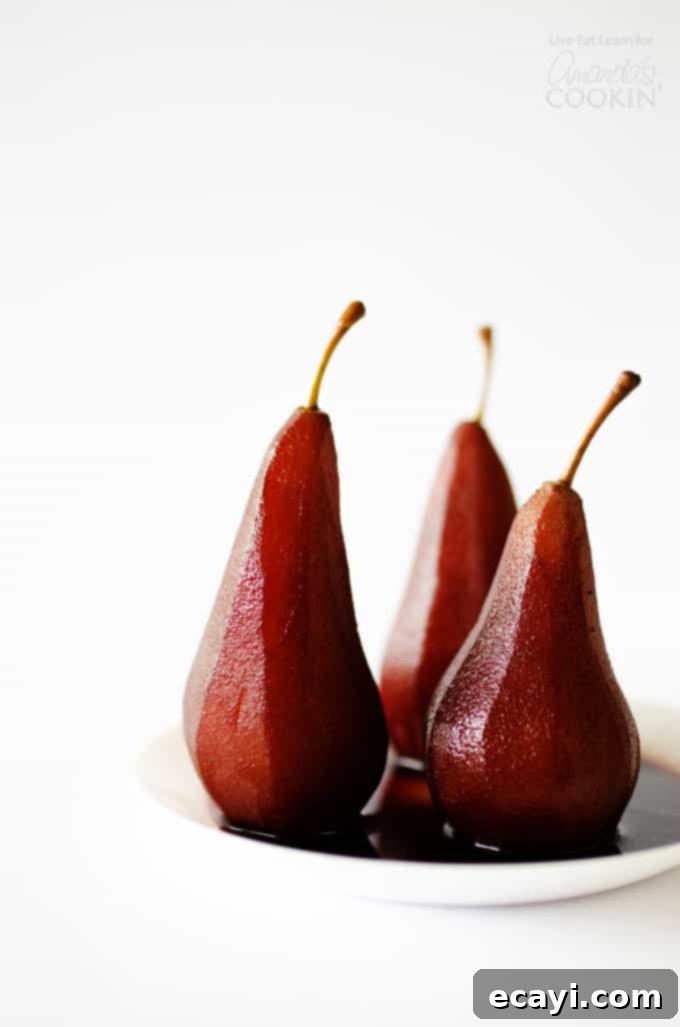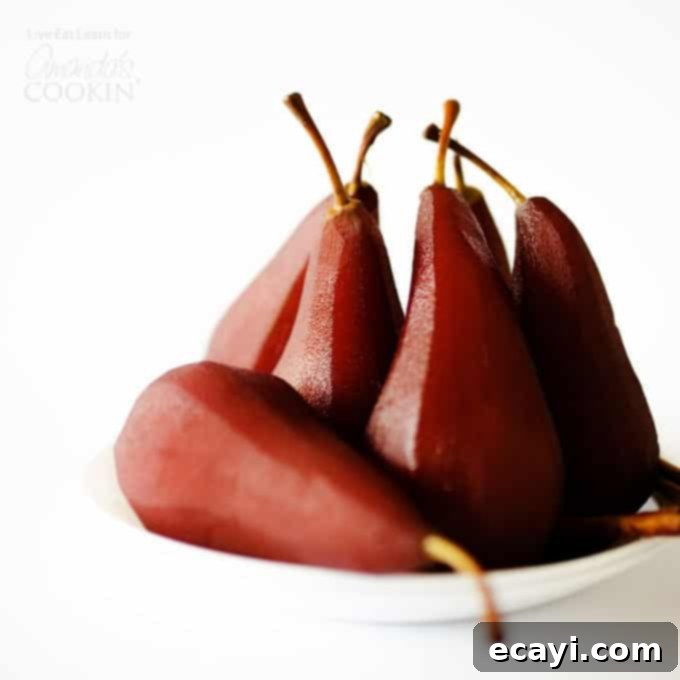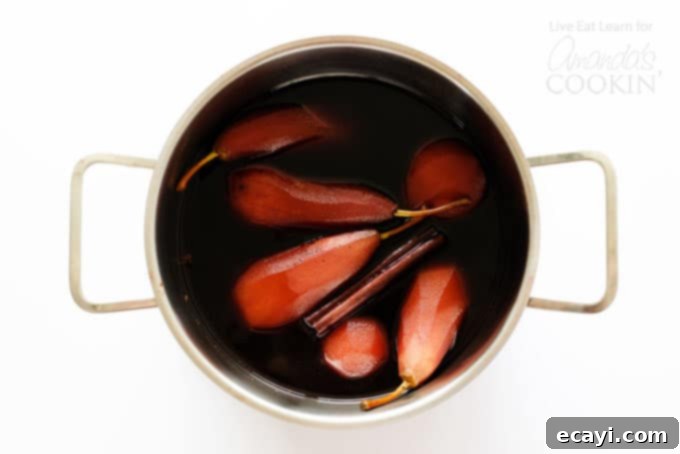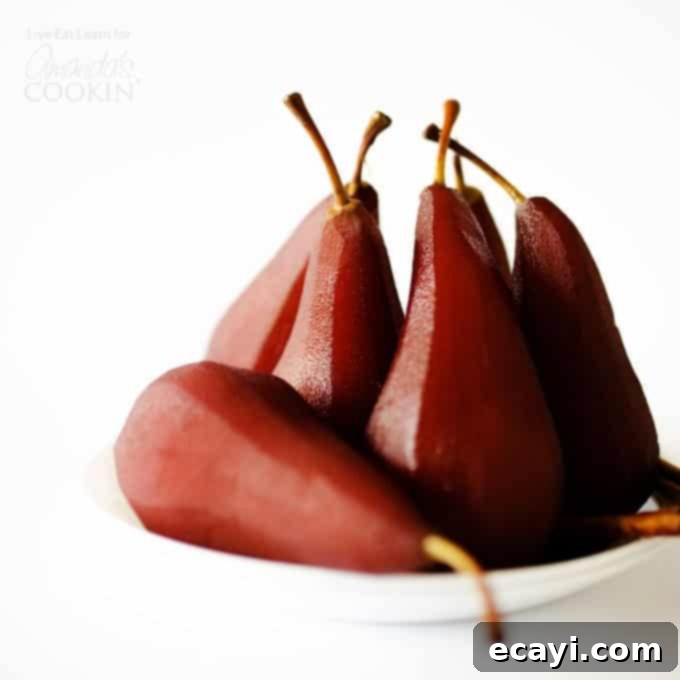Indulgent Red Wine Stewed Pears: A Traditional Dutch Winter Dessert Recipe
Craving a dessert that’s effortlessly elegant, bursting with cozy flavors, and leaves a lasting impression? Look no further than these exquisite Red Wine Stewed Pears! A beloved wintertime tradition in Holland, these spiced pears offer a perfect balance of sweet, fruity, and aromatic notes, making them an ideal treat for any occasion. While pears might often be overlooked, their versatility shines in countless desserts, from a rustic Pear-Peach Crisp to sophisticated tarts. This particular recipe, however, transforms humble pears into a show-stopping dish that’s surprisingly easy to master.

The Magic of Red Wine Stewed Pears: A Dutch Culinary Gem
While Dutch cuisine might not be globally renowned for its haute gastronomie – with its national dish often cited as a hearty mash of potatoes and kale with sausage (stamppot) – the Netherlands truly shines when it comes to the dessert department. They possess a unique talent for creating comforting, delightful sweet treats that warm the soul, especially during the colder months.
Consider the legendary stroopwafels: thin, crispy waffle cookies glued together with a rich caramel syrup – truly a taste of heaven on Earth. Then there are the adorable poffertjes, miniature puffed pancakes, dusted generously with powdered sugar and often served with a dollop of butter, especially on chilly days. But among these beloved sweets, one dessert holds a special place in the hearts of the Dutch: the humble yet magnificent stewed pears, or stoofpeertjes.
These aren’t just any stewed pears; they are simmered in a rich bath of red wine and infused with a symphony of warming spices, reminiscent of Christmas and festive celebrations. The Dutch traditionally prepare large batches of these fragrant pears, serving them alongside dinner, as a standalone dessert, or even for a luxurious breakfast. They are a staple at holiday gatherings and a comforting presence on winter tables, their deep red hue and spiced aroma filling homes with an inviting warmth.
Choosing the Perfect Pears for Stewing
A crucial element to the success of this Red Wine Stewed Pears recipe lies in selecting the right type and ripeness of pear. Around November, Dutch supermarkets stock special pear varieties specifically intended for stewing. These traditional “stoofpeertjes” are notoriously hard and require a significantly long simmering time – sometimes several hours – to become tender and absorb the stewing liquid’s flavors. While this slow-cooking method yields incredibly tender and deeply infused pears, it’s not always practical for a quick dessert.
For this recipe, I recommend a more accessible approach using slightly under-ripe pears that are typically eaten raw, such as Conference pears (as listed in the recipe), Bosc, or Anjou varieties. These pears are firmer than, say, a Bartlett pear, but not as rock-hard as traditional Dutch stewing pears. Their firm flesh allows them to hold their shape beautifully during the cooking process while still becoming wonderfully tender. The beauty of using slightly under-ripe pears is that they don’t require an excessively long cooking time – typically around 20-25 minutes. If you use very ripe pears, they will break down too quickly, resulting in a mushy texture rather than distinct, elegant pear halves. This shortcut means you can whip up this elegant dessert in under half an hour and enjoy it fresh, or allow them to cool and soak further in their aromatic juices in the fridge, deepening their flavor profile with every passing hour.

Essential Ingredients for Your Red Wine Stewed Pears
Creating these delightful Red Wine Stewed Pears requires a simple yet powerful combination of ingredients that work in harmony to produce their signature taste and texture:
- 6 conference pears: As discussed, these or similar firm, slightly under-ripe varieties are ideal for maintaining shape and absorbing flavor.
- 1 bottle (750 mL) dry red wine (I used Merlot): The star of the stewing liquid! A dry red wine like Merlot, Cabernet Sauvignon, or even a Pinot Noir will impart a deep, fruity, and slightly tannic flavor that beautifully complements the pears. Avoid overly sweet wines.
- 2 cups water: Balances the intensity of the red wine, creating a more mellow and palatable poaching liquid.
- 3 whole cloves: These small, potent spices provide a warm, sweet, and slightly pungent aroma, adding a classic festive note.
- 2 cinnamon sticks: Essential for that cozy, inviting fragrance and flavor. Cinnamon sticks are preferred over ground cinnamon for a cleaner, less cloudy liquid.
- ½ cup brown sugar: Adds sweetness and a rich, subtle caramel undertone that enhances the fruitiness of the pears and mellows the wine. You can adjust this to your taste or the sweetness of your pears and wine.
- 1 vanilla bean: The luxurious touch! A whole vanilla bean, split and scraped, infuses the liquid with its complex, aromatic, and sweet essence. It’s truly worth the indulgence.
Recommended Kitchen Tools for Perfect Pears
While the process is straightforward, having a few key tools on hand will make preparing your Red Wine Stewed Pears even easier:
- Large pot: Essential for simmering. Choose one that is wide enough to accommodate all the pears in a single layer or nearly so, allowing them to be mostly submerged in the stewing liquid. A heavy-bottomed pot helps with even heat distribution.
- Vegetable peeler: For cleanly and efficiently peeling the pears. A sharp peeler makes this task quick and safe.
- Nice serving tray: Once prepared, these elegant pears deserve a beautiful presentation, especially if serving for guests.
- Measuring cups: For accurate measurements of water and brown sugar, ensuring consistent results every time.

The Art of Stewing Pears: A Step-by-Step Guide
Making these Red Wine Stewed Pears is a delightful culinary journey that yields impressive results with minimal effort. Here’s how to create this festive and flavorful dessert:
Step 1: Preparing Your Pears
Begin by preparing your pears. To ensure they sit upright beautifully on a plate, carefully slice a small, flat portion from the bottom of each pear. This step isn’t just for aesthetics; it helps them cook more evenly in the pot. Next, using a vegetable peeler, gently remove the skin from each pear, working from the stem down to the base. Once peeled, set the pears aside while you prepare the aromatic poaching liquid. The goal is to keep them intact and smooth for an elegant presentation.
Step 2: Crafting the Aromatic Stewing Liquid
Place a large pot over medium heat. Into this pot, pour the full bottle of dry red wine, followed by the water. Add the whole cloves and cinnamon sticks, which will infuse the liquid with their warm, spicy notes. Stir in the brown sugar until it dissolves, creating a subtly sweet base. For the vanilla bean, carefully split it lengthwise down the middle with a sharp knife. Use the back of the knife to scrape out the tiny, fragrant seeds directly into the pot. Don’t discard the pods – throw them into the pot as well, as they contain a lot of flavor that will continue to release during simmering. Bring this mixture to a gentle simmer, just until the sugar is fully dissolved and the spices begin to release their intoxicating aroma.
Step 3: Gentle Simmering to Perfection
Once your aromatic liquid is simmering gently, carefully add the prepared pears to the pot. Arrange them so they are mostly submerged in the wine mixture. If any pear isn’t fully covered, you can gently turn it occasionally or add a splash more water or wine to ensure even cooking and color. Cover the pot with a lid and reduce the heat to low, maintaining a very gentle simmer. Allow the pears to cook for approximately 20-25 minutes, or until they are tender when pierced with a knife, but still hold their shape. The cooking time will vary depending on the ripeness and variety of your pears. Keep an eye on them to prevent overcooking, which could result in a mushy texture.
Step 4: Serving and Storing Your Delicious Pears
Once the pears are perfectly tender, remove them from the heat. These Red Wine Stewed Pears are absolutely divine when served warm and fresh, perhaps straight from the pot. The vibrant red color and festive aroma make them an instant hit. For any leftovers, simply store them in an airtight container in the refrigerator, ensuring they remain submerged in their flavorful wine juice. This not only preserves them but also allows them to continue soaking up the wonderful spices, often tasting even better the next day as the flavors deepen and meld together. They can be gently reheated or enjoyed chilled.
Beyond the Recipe: Serving Suggestions and Variations
These Red Wine Stewed Pears are a fantastic holiday spiced treat, versatile enough to be enjoyed for breakfast, lunch, or dinner. Their rich flavor and elegant presentation make them suitable for any meal. They are truly exceptional on their own, but here are some ideas to elevate your serving experience and explore variations:
Creative Serving Ideas:
- Classic Dessert: Serve warm with a scoop of vanilla bean ice cream or a dollop of freshly whipped cream. The contrast of warm pears and cold cream is simply divine.
- Elegant Touch: A spoonful of creamy mascarpone cheese or Greek yogurt provides a lovely counterpoint to the sweetness and spice.
- Breakfast Delight: Chop cooled pears and serve over oatmeal, pancakes, or French toast. The spiced syrup can also be drizzled over.
- Cheese Board Companion: Unexpectedly, these pears pair wonderfully with soft cheeses like brie or goat cheese, offering a sweet and savory element to your appetizer spread.
- Garnish: A sprinkle of chopped pistachios, toasted almonds, or a sprig of fresh mint can add both visual appeal and textural contrast.
Flavorful Variations to Try:
- Citrus Zest: Add a strip of orange or lemon peel to the stewing liquid for a brighter, more zesty flavor profile.
- Other Spices: Experiment with star anise, a slice of fresh ginger, or a few cardamom pods for different aromatic dimensions.
- Boozy Boost: For an extra layer of warmth, add a splash of brandy, port, or Grand Marnier to the stewing liquid towards the end of the cooking process.
- Sweetener Alternatives: Instead of brown sugar, you could try maple syrup or honey for a slightly different kind of sweetness.
- Non-Alcoholic Version: If you prefer to avoid alcohol, grape juice (especially dark grape juice) or non-alcoholic red wine can be used as a substitute, maintaining the beautiful color and some of the fruitiness.
I also found these Cinnamon Poached Pears made in the pressure cooker that you might enjoy if you’re looking for an even quicker preparation method!
Frequently Asked Questions About Red Wine Stewed Pears
What kind of red wine is best for stewing pears?
A dry, medium-bodied red wine works best. Varieties like Merlot, Cabernet Sauvignon, or Pinot Noir are excellent choices as they offer fruity notes without being overly sweet or tannic. Avoid very heavy, oaky wines or overly sweet dessert wines, as they can overpower the delicate flavor of the pears.
Can I use other spices besides cloves and cinnamon?
Absolutely! While cloves and cinnamon are traditional, you can customize the spice blend. Star anise, a few slices of fresh ginger, a grating of nutmeg, or even a bay leaf can add intriguing complexity. Orange or lemon zest can also brighten the flavor profile beautifully.
How long do red wine stewed pears last in the refrigerator?
When stored in an airtight container, submerged in their poaching liquid, these stewed pears will last for up to 5-7 days in the refrigerator. In fact, many find their flavor deepens and improves after a day or two as the pears continue to soak up the spiced wine.
Can I make these stewed pears without alcohol?
Yes, you can! For a non-alcoholic version, substitute the red wine with an equal amount of dark grape juice (such as Concord grape juice), cranberry juice, or even a non-alcoholic red wine alternative. You’ll still get a beautiful color and fruity flavor, especially when paired with the spices and vanilla.
Can I freeze stewed pears?
While technically possible, freezing is not generally recommended for stewed pears. Pears can become mushy and lose their firm texture upon thawing, which detracts from the overall experience. It’s best to enjoy them fresh or refrigerated within a week.
For more holiday inspired desserts be sure to check out…
- Candy Cane Danish
- Chocolate Peppermint Trifle
- Homemade Peanut Brittle
- 40+ Pie Recipes, Crust Types, Spice Mixes, and Homemade Fillings

Red Wine Stewed Pears
IMPORTANT – There are often Frequently Asked Questions within the blog post that you may find helpful. Simply scroll back up to read them!
Print It
Pin It
Rate It
Save ItSaved!
Ingredients
- 6 medium conference pears
- 750 ml dry red wine
- 2 cups water
- 3 whole cloves
- 2 each cinnamon sticks
- ½ cup brown sugar
- 1 each vanilla bean
Instructions
-
Cut a small portion of the bottom of each pear off so they can sit upright. Peel the skin from each, then set aside.
-
Set a large pot over medium heat and add the wine, water, cloves, cinnamon, and sugar. Split the vanilla bean down the middle, scrape the seeds into the pot, then throw the pods in the pot as well.
-
Add the pears, making sure they’re mostly covered by the wine, then cover and let gently simmer for 20 minutes, or until pears are soft.
-
Serve warm and fresh, or store leftovers in the wine juice in the fridge.
Nutrition
The recipes on this blog are tested with a conventional gas oven and gas stovetop. It’s important to note that some ovens, especially as they age, can cook and bake inconsistently. Using an inexpensive oven thermometer can assure you that your oven is truly heating to the proper temperature. If you use a toaster oven or countertop oven, please keep in mind that they may not distribute heat the same as a conventional full sized oven and you may need to adjust your cooking/baking times. In the case of recipes made with a pressure cooker, air fryer, slow cooker, or other appliance, a link to the appliances we use is listed within each respective recipe. For baking recipes where measurements are given by weight, please note that results may not be the same if cups are used instead, and we can’t guarantee success with that method.

